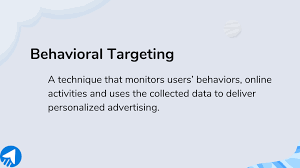1. What is Behavioral Targeting?
- Definition: Behavioral targeting involves tracking user behavior online, such as website visits, search queries, and interactions with content, to tailor advertisements that align with their interests.
- Purpose: The primary goal is to show ads that are more relevant to users, increasing the likelihood of engagement and conversion.
2. How Behavioral Targeting Works
-
Data Collection:
- Cookies: Small files stored on users’ devices that track their browsing activities.
- Tracking Pixels: Invisible images embedded in web pages or emails that help collect data on user interactions.
- User Profiles: Aggregated data from various sources (e.g., social media, purchase history) to create comprehensive profiles of users.
-
Segmentation: Based on collected data, users are segmented into different categories, such as:
- Interest-Based Segments: Users interested in specific topics (e.g., travel, fitness).
- Behavioral Segments: Users who exhibit certain behaviors (e.g., frequent buyers, window shoppers).
-
Ad Delivery:
- Real-Time Bidding (RTB): Advertisers bid for ad placements in real time based on the user’s profile and behavior.
- Personalized Ads: Ads are served that match the interests and behaviors of the user, increasing relevance.
3. Benefits of Behavioral Targeting
- Increased Relevance: Ads are more aligned with user interests, leading to higher engagement rates.
- Higher Conversion Rates: Personalized ads can significantly improve the likelihood of users taking desired actions (e.g., clicking, purchasing).
- Cost Efficiency: Advertisers can optimize their budgets by targeting users who are more likely to convert, reducing wasted ad spend.
4. Challenges and Considerations
- Privacy Concerns: Users are increasingly concerned about their privacy and how their data is being used. Compliance with regulations (e.g., GDPR, CCPA) is essential.
- Ad Fatigue: Overexposure to the same ads can lead to diminishing returns, where users become desensitized to the ads.
- Data Accuracy: The effectiveness of behavioral targeting relies on the accuracy of the data collected. Inaccurate data can lead to irrelevant ad placements.
5. Best Practices for Implementing Behavioral Targeting
- Transparency: Clearly communicate to users how their data is being collected and used. Provide options for opting out.
- Diverse Targeting Strategies: Combine behavioral targeting with other strategies (e.g., contextual targeting, demographic targeting) for a more comprehensive approach.
- Regular Analysis: Continuously analyze the performance of targeted ads and adjust strategies based on user engagement and conversion data.
Conclusion
Behavioral targeting is a powerful tool in digital advertising that can significantly enhance the relevance and effectiveness of ad campaigns. By leveraging user data responsibly and ethically, advertisers can create personalized experiences that resonate with their audience, leading to improved engagement and conversion rates.
Check Out:
Young Urban Project Performance Marketing Course
Duration: 10 weeks (online)
Key Features:
- Fundamentals: Learn performance marketing basics, data-driven strategies, and ROI measurement.
- Hands-On Tools: Gain experience with Google Ads, Facebook Ads, and Google Analytics.
- Expert Instructors: Learn from industry professionals with real-world experience.
- Community Support: Connect with peers and mentors.
